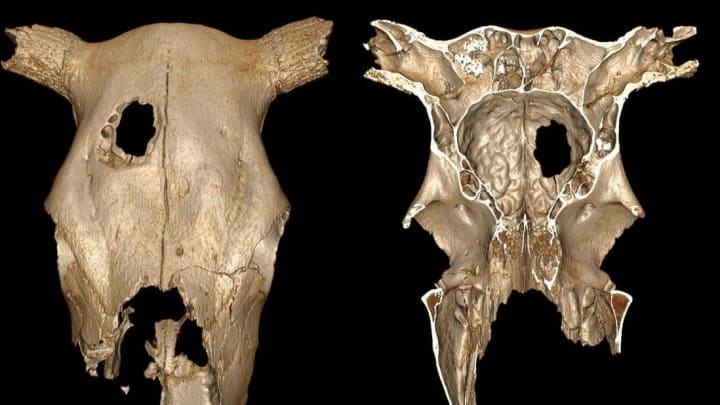In the 1970s, archaeologists discovered a site in France containing hundreds of cow skeletons dating back 5000 to 5400 years. The sheer number wasn't surprising—human agriculture in that part of the world was booming by 3000 BCE. What perplexed scientists was something uncovered there a few decades later: a cow skull bearing a thoughtfully drilled hole. Now, a team of researchers has released evidence that suggests the hole is an early example of animal brain surgery.
Fernando Ramírez Rozzi, a paleontologist with the French National Center for Scientific Research, and Alain Froment, an anthropologist at the Museum of Mankind in Paris, published their findings in the journal Nature Scientific Reports. After comparing the opening to the holes chiseled into the skulls of humans from the same era, they found the bones bore some striking similarities. They didn't show any signs of fracturing from blunt force trauma; rather, the hole in the cow skull, like those in the human skulls, seemed to have been carved out carefully using a tool made for exactly that purpose. That suggests that the hole is evidence of the earliest known veterinary surgery performed by humans.
Trepanation, or the practice of boring holes into human skulls, is one of the oldest forms of surgery. Experts are still unsure why ancient humans did this, but the level of care that went into the procedures suggests that the surgery was likely used to treat sick patients while they were still alive. Why a person would perform this same surgery on a cow, however, is harder to explain.
The authors present a few theories, the first being that these ancient brain surgeons were treating a sick cow the same way they might treat a sick human. If a cow was suffering from a neural disease like epilepsy, perhaps they though that cutting a hole in its head would relieve whatever was agitating the brain. The cow would have needed to be pretty special to warrant such an effort when there were hundreds of healthy cows living on the same plot of land, as evidenced by the skeletons it was found with.
Another possible explanation was that whoever operated on the cow did so as practice to prepare them for drilling into the heads of live humans one day. "Cranial surgery requires great manual dexterity and a complete knowledge of the anatomy of the brain and vessel distribution," the authors write in the study. "It is possible that the mastery of techniques in cranial surgery shown in the Mesolithic and Neolithic periods was acquired through experimentation on animals."
Either way, the bovine patient didn't live to see the results of the procedure: The bone around the hole hadn't healed at all, which suggests the cow either died during surgery or wasn't alive to begin with.
